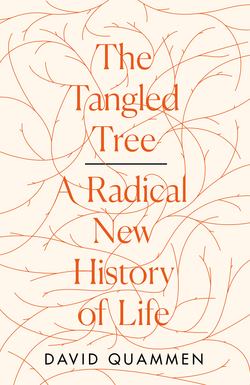Читать книгу The Tangled Tree: A Radical New History of Life - David Quammen, David Quammen - Страница 26
18
ОглавлениеAs of early 1976, with Ken Luehrsen and others still helping, Woese had done his unique form of catalog analysis on samples from roughly thirty species, using differences in ribosomal RNA molecules to measure their relatedness. Most were prokaryotes, but he also looked at a few eukaryotes (which carried that slightly different molecule in their ribosomes, 18S rRNA instead of 16S), including yeast, for purposes of gross comparison. He could tell a prok from a euk just by inspecting the spots on a sheet of film. And he was eager to see those “unusual bacteria,” the methanogens, about which Ralph Wolfe had alerted him.
The tricky thing about methanogens was that, since oxygen poisoned them, they were hard to grow in a laboratory. But Wolfe’s lab team included an ingenious doctoral student, Bill Balch, who had solved that problem by devising a way to culture methanogens in pressurized aluminum tubes with black rubber stoppers, and using syringes to move things in and out. Balch gave the methanogens an atmosphere of hydrogen and carbon dioxide instead of oxygen, plus a liquid growth medium, and they thrived. Woese sent his own postdoc, a rangy young man named George Fox, trained in chemical engineering, to work with Balch on growing some of these methanogens and tagging them with radioactive phosphorus. Fox, Ken Luehrsen, and other members of the Woese lab then combined their efforts on the rest of the process: extracting the radioactive RNA, purifying it to get concentrations of 16S and 5S molecules, chopping those molecules into pieces, running the electrophoresis to separate the fragments, and printing the spots onto films. Their first methanogen carried a formal name so long (Methanobacterium thermoautotrophicum) that even Woese himself dismissed that as “a fourteen-syllable monstrosity” and preferred using a shorter label, denoting the particular laboratory strain: delta H. Examining its primary fingerprint on his light board, Woese noticed something odd.
He was practiced enough by now at reading such fingerprints that he could immediately recognize a certain pair of small fragments, common to all bacteria, that “screamed out” their membership in the prokaryotes. He looked for them on the primary film from delta H. They were missing. Intrigued but patient, he waited for the secondary fingerprint, with the fragments pulled sideways to reveal more detail. He got that from his technician several days later. On June 11, 1976, he taped the primary film up on his light board again, with the secondary now in front of him on the light table, and began trying to interpret what he saw. He intended, as usual in this stage of the process, to use the secondary film as a guide for inferring the base sequences of the fragments in the primary pattern. Apart from his board and his table, the room was dark. His face, we can imagine, reflected an eerie glow. Quickly he noticed more oddities.
The two missing fragments were still missing, but it wasn’t just that. Woese turned to a different part of the pattern, expecting to see another familiar fragment—a “signature” sequence in all prokaryotes. Not there. Instead, he found a strange fragment, a longish sequence that shouldn’t have been present at all. “What was going on?” he later recalled wondering. This methanogen rRNA just “was not feeling” prokaryotic. And the more fragments he sequenced, the less prokaryotic it felt. By this time, he knew the sequences of ribosomal RNA in bacteria so intimately that his “feel” for the molecule was a persuasive standard of normality. And something in this particular creature, delta H, was abnormal. Some bacterial fragments were appearing where expected, as expected, yes. But some others looked eukaryotic, suggesting a completely distinct form of life: a yeast, a protozoan, what? And still others were just weird. What was this RNA? he wondered, and what manner of organism did it represent? It couldn’t be from a prokaryote. It wasn’t eukaryotic. It wasn’t from Mars, because it contained too many familiar stretches of RNA code. “Then it dawned on me,” he wrote. There was “something out there”—out there in the teeming ecosystems of planet Earth, he meant—other than prokaryotes and eukaryotes. A third form of life, separate.
Woese called this, whimsically, his “out-of-biology experience.” It would be the watershed moment of his scientific life.
